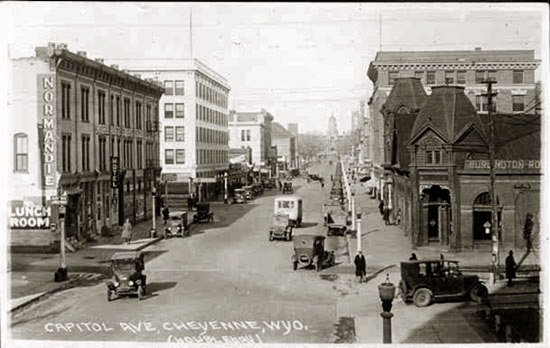
Capitol Avenue, looking north, 1920's. Photo by Ralph Doubleday.
The Hynds Building was completed in 1920. The building was designed by William R. Dubois and housed the American National Bank until 1964.
The bank is now located on 20th and Capitol. The building has been vacant for a number of years, but is proposed for
renovation. In 2003, a drug addict managed to get to the roof where he threatened to
jump. He used his
perch to throw, among other things, tarot cards at police officers. Suicide, however, was not in the
cards that day and after five hours he was taken into custody.
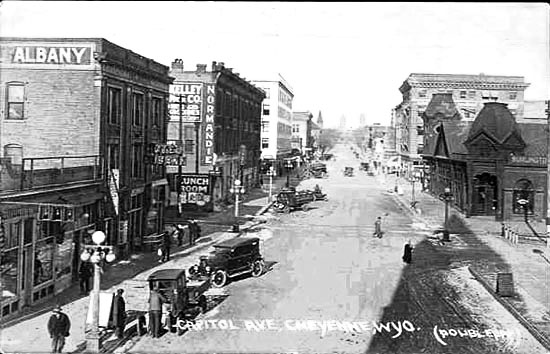
Capitol Avenue, looking north, 1920's. Photo by Ralph Doubleday.
Note the individual with car touble parked on the left.
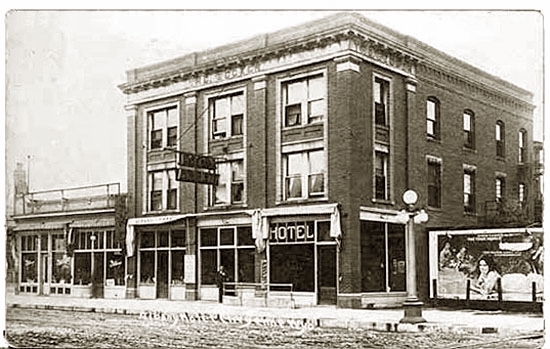
Albany Hotel, undated.
The Burlington Station across the street from the Albany Hotel was first replaced
with a new depot which later became a bus station. The site is now a park.
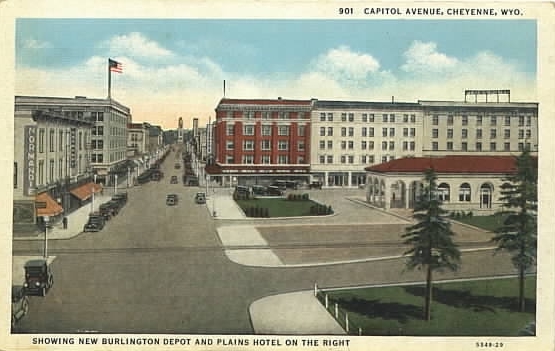
Capitol Ave., 1920's.
In this scene, the old Burlington Depot is now gone.
A comparison with the 1909 view of 16th reflects that the one-story building next to First National Bank
has been replaced.
As indicated by the above photos, Cheyenne was
a very modern city, as confirmed by Emily Post in her description of her 1915
motor journey from New York to Denver:
If you think Cheyenne is a Buffalo Bill Wild West town, as we did, you
will be much disappointed, though it may be well not to show the
progressive citizens of that up-to-date city that you hoped they
were still galloping along wooden sidewalks howling like coyotes!
I thought that Celia and E.M. [Post's traveling companions] looked distinctly grieved at the sight
of smooth laid asphalt, wide-paved sidewalks, imposing capitol and modern buildings.
Even the brand-new Plains Hotel was accepted by both of them in much the same spirit
that a child who thought it was going to the circus and found itself at a museum of art,
would accept the compensation of a nice hot supper instead of peanuts and red lemonade. . . The west of yesterday was no longer to be found in Cheyenne!
On one day in the year though, they have a Frontier Days Celebration---when,
like in the midnight hour of the Puppen Fee, the West that was comes
back to life. There are wonderful exhibits of "bronco busting" and rope
throwing, and all the features of county fair, horse show, and wild west
show in one.
For discussion of the Plains Hotel, see
Lincoln Highway.
Dudley Stevenson on Red Bird, photo by J. E. Stimson
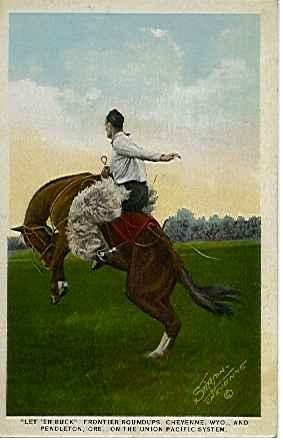 Joseph Elam Stimson was the official photographer for the
Union Pacific in Cheyenne from 1889 to 1903. A large collection of his photographs are
held by the American Heritage Center of the University of Wyoming. Other photographs are
held by the Wyoming State Museum and some are on display in the Old Governor's Mansion. Other
examples of his work will be found on the Cattle Drives and
Rudafeha Mine pages.
Joseph Elam Stimson was the official photographer for the
Union Pacific in Cheyenne from 1889 to 1903. A large collection of his photographs are
held by the American Heritage Center of the University of Wyoming. Other photographs are
held by the Wyoming State Museum and some are on display in the Old Governor's Mansion. Other
examples of his work will be found on the Cattle Drives and
Rudafeha Mine pages.
In contrast to Miss Post's comments, always the epitome of politeness, were the
comments of James Montgomery Flagg, primarily noted as the artist who created
the World War I Uncle Sam, "I want you!" poster, on his 1925 honeymoon trip
across the continent:
The roads are getting worse again,
and I hate to look at them, even when visible. We went thro Laramie to
Cheyenne. The street around the Plains Hotel was entirely torn up, and the
shabbiness, the dust, and the hard day's ride all combined to make me laugh
sardonically at the seriousness with which Cheyenne took itself.
As everyone knows, it is the scene of the big yearly rodeo, and no one
talks of anything else the year around I suspect. The post cards are all
on one subject---a horse giving an imitation of interpretive dancing, and
a cow person leaving his saddle for the plains at once!
I bought a couple of silk bandanas in a haberdashery, and the proprietor,
when I told him I wanted to get some fried chicken to take to the M.Q.["Motor Queen", the
reference to his new bride], who was then sleeping exhaustedly at the hotel,
at once left his store flat and, without his hat, escorted me to several
cafes to help find the chicken. That impulsive friendliness made me forget
the mood I arrived in and think kindly of Cheyenne.
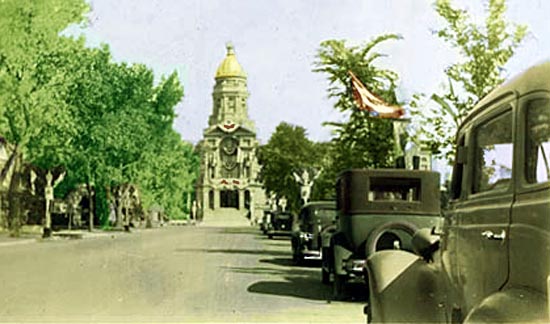
2300 Block, Capitol Ave., approx. 1936.
Compare with same scene on previous page. The City park is to the right.
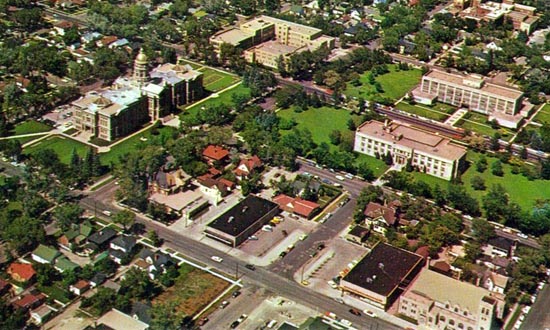
Aerial view of Capitol, 1970.
The building fronting Capiol Ave. in what was once the city park is the Wyoming Supreme Court Building.
To the east of the Supreme Court, at 2301 Central Avenue is the Barrett Building which houses, among other agencies, the
Wyoming State Archives. The Supreme Court Building was constructed in 1938 as a Works Progress Administration Project. Its
Supervising Architect was Wiiliam R. Dubois, the designer of a number of building throughout
Cheyenne and at the University of Wyoming. The Barrett Building was constructed in 1950.
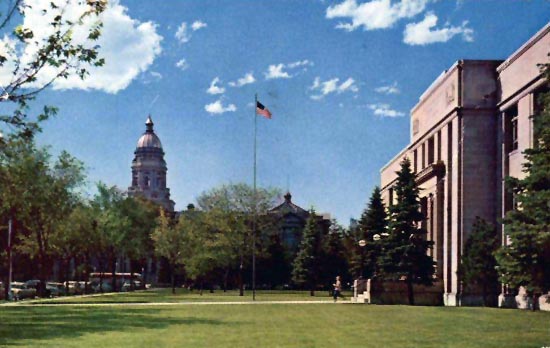
Supreme Court Building, looking north to Capitol Building.
In 2009, the Supreme Court Building was renovated including a redesign of the Suprem Court Room which previously
was small, dark and windowless, very much like the courtroom one time in a Forida Court of Appeals which
was stuck in the basement of that
state's Supreme Court Building.
Cheyenne Photos continued on next page.
|